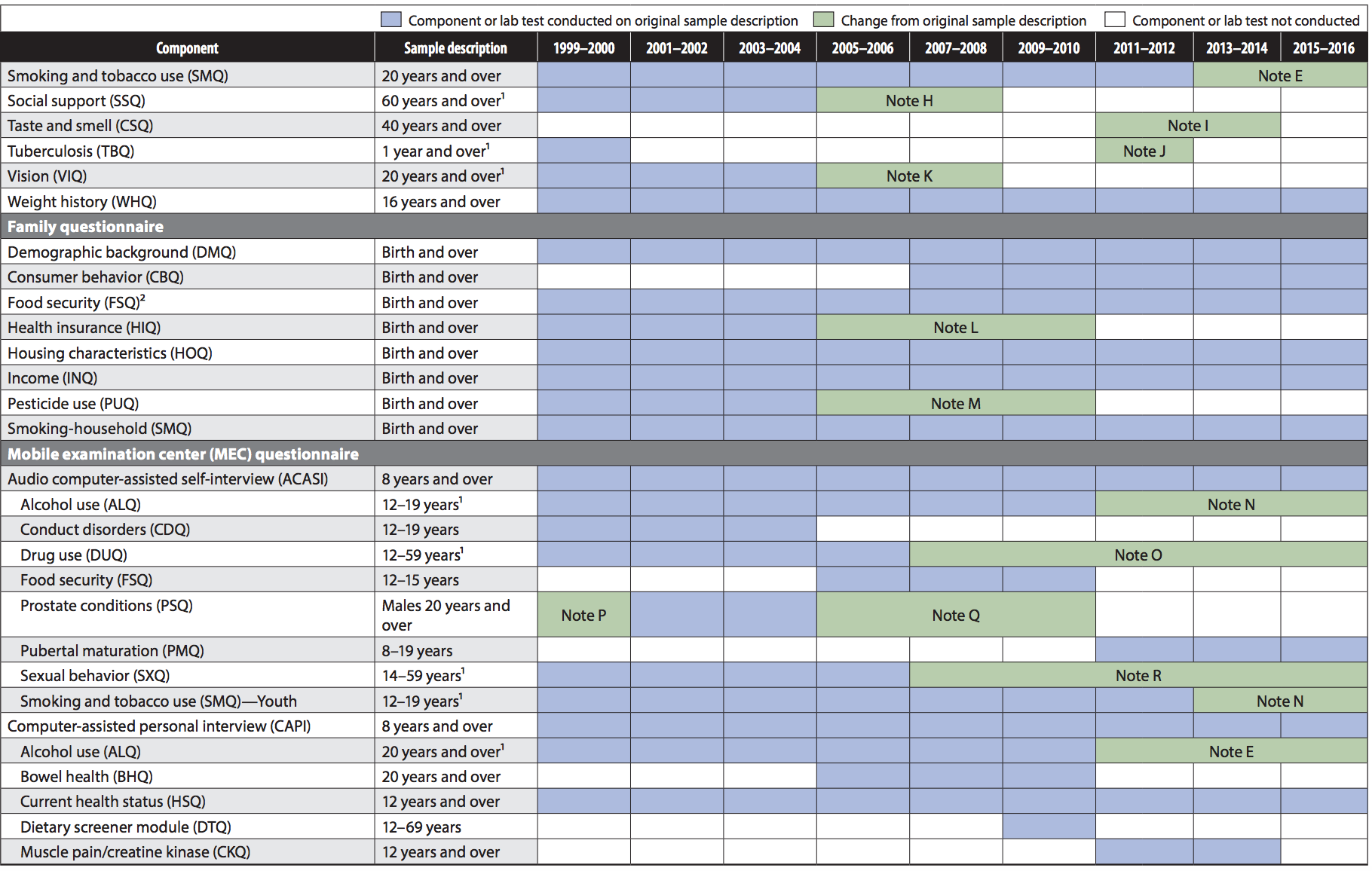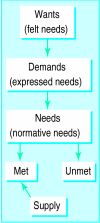Background / Definition
Created in 1959, the National Health and Nutrition Examination Survey (NHANES) is an annual program which measures the overall health and nutrition of adults and children of certain regions in order to understand the health issues in the United States. This program was started by the National Center of Health Statistics, a branch of the Center for Disease Control and Prevention (CDC). The point of this survey is to gather data on health trends and needs of the nation in order for public health officials to adopt policies and initiatives to respond to those needs (Resnick 2013).
Each year, NHANES workers survey 5000 selected people in selected regions whom public health officials believe to be representative of the nation’s health needs. Depending on current health trends, public health officials choose to survey certain demographics and regions more or less (Resnick 2013). For example, in 1999, the focus of the study was on the youth and the elderly, so although many adults were surveyed, the emphasis was placed on certain groups (Smith 1999 190). The process consists of two parts: a physical exam and an interview. During the interview portion, which takes place in the subject’s home, officials ask the subject questions about demographic, socioeconomic status, dietary information, exercise level, and other health-related questions such as family size, drug use, whether or not the subject uses a form of birth control, etc. (Smith 1999 191). The medical exam, performed in mobile units such as the one pictured below, includes a standard physical, a dental exam, and a psychological exam (Resnick 2013).

Context
Although NHANES began in 1959, in its early years it was neither continuous nor periodical. Rather, surveys were performed whenever public health officials deemed it necessary, which often meant several year-long gaps between surveys. In 1999, however, the program became a continuous, annual event (Smith 1999 190).
While NHANES does change every year to address specific health needs, as shown in the data set below, many NHANES sections permanently cease to exist after officials realize the insignificance and usefulness of such data, or they appear for the first time and continue to appear years later because officials suddenly recognize their importance. For example, while heath officials decided in 2010 that health insurance and pesticide use were no longer important components of the survey, they did add pubertal maturation and consumer behavior after not having previously using it (“About” 2016).

Findings from NHANES surveys have been instrumental in countless public health initiatives, programs, and national health standards. Generally, NHANES data has led to national standards for height, weight, and blood pressure and the use of growth charts by pediatricians for their patients (Resnick 2013). Specifically, NHANES data first documented statistics on overweight and obese patients, and discovered the importance of physical activity to a healthy life. These findings led to nutrition and exercise initiatives to inform children and adults of the benefits of exercising and eating healthy (Smith 1999 192). Some NHANES officials claim that NHANES’s biggest success was their collection of data on blood lead levels (“The NHANES Story” 2010). Their data led to the removal of lead from gasoline, food and soda cans, and paint, resulting in a 70% decrease of blood lead levels from 1970-1999 (Smith 1999 192). Other important successes of NHANES include the documentation of undiagnosed diabetes, the first set of data on tobacco use and its effects, and measures of blood folate levels (“The NHANES Story” 2010).
Controversies
While the beneficial effects of NHANES are inarguable, many critics find fault in the way NHANES is administered. The most common complaint, which Subar et al. discuss in their article “Addressing Current Criticism Regarding the Value of Self-Report Dietary Data” (Subar et al. 2015). is that any health survey which includes a self-report section are doomed to yield erroneous data, especially with diet and exercise self-reports, one of the key sections of NHANES. Such critics believe that subjects have a tendency to underreport their food consumption (or energy intake) and misreport their physical activity levels, often by no fault of their own. NHANES collects dietary self-reports in three ways: food frequency reports (FFQs), 24 hour reports (24hrs), and food records (FRs). According to NHANES critics, each of these methods is flawed. FFQs, where subjects are given booklets containing around 125 food items and told to report how often they eat these items in a given time period, are the most frequently used form of dietary reports for NHANES. The problem with FFQs, however, are twofold. First, these booklets do not contain nearly all of the items which subjects may eat on a semi-regular basis. Second, these booklets do not indicate preparation or portion size. For example, if a subject ate one skinless grilled chicken breast once a week, it would appear the same as a subject who eats three servings of deep-fried chicken with the same frequency. However, these two meals are clearly different health-wise. 24hrs, interviews where subjects are told to recount their food consumption from the last 24 hours, are flawed in that subjects often forget what and what size portion they ate, and that one 24-hour time span is not necessarily indicative of a subject’s typical diet. Finally, FRs, where subjects are told to keep a food log for a week or so, are arguably the most flawed. Since many subjects log their food at the end of the day rather than in real time, FRs present the same difficulties as 24hrs. In addition, when subjects know their food consumption is being monitored, they often display a tendency to eat more healthily than they typically would (Subar et al. 2015 2640).
Such critics believe that data collected from surveys such as NHANES are so unreliable that they should not be the basis of any policymaking. While Subar et al. do concede that such data is useful in identifying certain foods and beverages which are widely consumed, quantitative measurements are too flawed to be useful (Subar et al. 2015 2641). Many critics agree, and one study actually showed that, if the dietary reporting collected in the United Kingdom in 2001 had been accurate, the nation’s population would have all displayed almost an eight-pound weight loss by 2005 (Schoeller et al. 2013 1413). In short, critics of NHANES and other such surveys believe that while dietary self-reporting is currently the best method for gathering nutritional data, that does not mean it is sufficient and that we should trust their findings (Schoeller et al. 2013).
Despite criticism of the way NHANES is administered, very few debate the usefulness and importance of a health needs assessment. In their article “Development and Importance of Health Needs Assessment” (Wright et al. 1998), Wright et al. define a health needs assessment as a method of understanding a certain population’s public health needs, and a way to frame health services to respond to said needs (Wright et al. 1998 1310). As shown in the diagram below, health needs do not always correlate to a response from the medical field (Wright et al. 1998 1311). According to Wright et al., merely observing the health of patients who visit physicians is insufficient in determining a population’s health needs, as not all those who need medical attention seek it. Further, with limited resources and availability in the health care industry and rising health needs, politicians and physicians are under much pressure to focus their decisions on the overall needs of a population rather than individualized care for a certain patient, creating a need for health assessment surveys such as NHANES (Wright et al. 1998).

Politics of Health
The National Health and Nutrition Examination Survey relates to politics of health through the use of NHANES data to create public health initiatives and programs. For example, during one iteration of NHANES, officials discovered that diabetes was largely undiagnosed in the nation, leading to campaigns on diabetes awareness among minority groups who may not see a doctor regularly enough to know what diabetes is, how to treat it, or even that they have it (Smith 1999 192). By compiling a set of data which shows health trends among populations and regions, policymakers can have a better of understanding of how to approach epidemics and which demographics to target with their campaigns. Overall, many health initiatives and common health knowledge, such as the importance of exercise and the dangers of tobacco use, would not exist today were it not for the creation of NHANES in 1959.
References
About the National Health and Nutrition Examination Survey. (2016). Retrieved from Center for Disease Control and Prevention website: https://www.cdc.gov
The NHANES Story. (2010). Retrieved from Centers for Disease Control and Prevention website: https://www.cdc.gov/nchs/nhanes/nhanes-story.htm
Resnick, B. (2013). National Health and Nutrition Examination Survey (NHANES). In M. D. Gellman (Ed.), Encyclopedia of Behavioral Medicine. Retrieved from https://link.springer.com
Schoeller, D. A., Thomas, D., Archer, E., Heimsfield, S. B., Blair, S. N., Goran, M. I., . . . Allison, D. B. (2013). Self-report–based estimates of energy intake offer an inadequate basis for scientific conclusions. The American Journal of Clinical Nutrition. Retrieved from http://ajcn.nutrition.org/
Smith, S. S. (1999). NCHS Launches Latest National Health and Nutrition Examination Survey. National Center for Health Statistics Dataline. Retrieved from JSTOR database.
Subar, A. F., Freedman, L. S., Tooze, J. A., Kirkpatrick, S. I., Boushey, C., Neuhouser, M. L., . . . Krebs-Smith, S. M. (2015). Addressing Current Criticism Regarding the Value of Self-Report Dietary Data. The Journal of Nutrition. Retrieved from http://jn.nutrition.org
Wright, J., Williams, R., & Wilkinson, J. R. (1998). Development and importance of health needs assessment. The BMJ. Retrieved from https://www.ncbi.nlm.nih.gov
Wyatt, M. R., Johnston, T., Papas, M., & Taufer, M. (2016). Development of a Scalable Method for Creating Food Groups Using the NHANES Dataset and MapReduce. Proceedings of the 7th ACM International Conference on Bioinformatics, Computational Biology, and Health Informatics. Retrieved from ACM Digital Library database.
« Back to Glossary Index